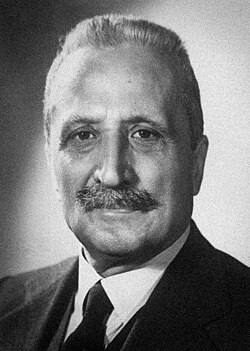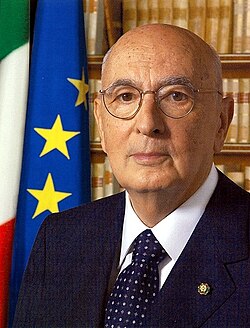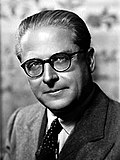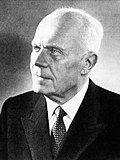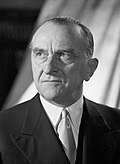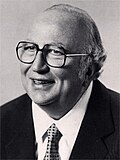Top Qs
Timeline
Chat
Perspective
List of presidents of Italy
From Wikipedia, the free encyclopedia
Remove ads
The president of Italy (Italian: Presidente della Repubblica) is the head of state of the Italian Republic. Since 1948, there have been 12 presidents of Italy.
- Top left: Enrico De Nicola was the first president of the Italian Republic.
- Top right: Antonio Segni was the first president to resign from office.
- Bottom left: Giorgio Napolitano was the first president to be re-elected.
- Bottom right: Sergio Mattarella is the current president of the Italian Republic and the longest-serving president in Italian history.
The official residence of the president is the Quirinal Palace in Rome. Among the Italian presidents, three came from Campania (all from Naples), three from Piedmont, two each from Sardinia (both from Sassari) and from Tuscany, one from Liguria, and one from Sicily. No woman has ever held the office.
Remove ads
Election
The president of the Republic is elected by Parliament in a joint session of the Chamber of Deputies and the Senate. In addition, the 20 regions of Italy appoint 58 representatives as special electors. Three representatives come from each region, save for the small Aosta Valley which appoints one, so as to guarantee representation for all localities and minorities.
According to the Constitution, the election must be held in the form of secret ballot, with all senators, all deputies and the 58 regional representatives all voting. A two-thirds vote is required to elect on any of the first three rounds of balloting and after that a majority suffices. The election is presided over by the Speaker of the Chamber of Deputies, who calls for the public counting of the votes. The vote is held in the Palazzo Montecitorio, home of the Chamber of Deputies, which is expanded and re-configured for the event.
The president assumes office after having taken an oath before Parliament and delivering a presidential address. Presidents are elected to serve a seven-year term. Giorgio Napolitano was the first president to be elected to a second term in 2013, followed by Sergio Mattarella in 2022.
Remove ads
Presidents of the Italian Republic (1948–present)
Timeline

Remove ads
Substitute of the head of state
Summarize
Perspective
The Acting President of the Republic (Italian: Presidente supplente della Repubblica) is an office not explicitly provided for in the Italian Constitution, but deriving from the provision contained in the article 86.[13] On various occasions, officials had to intercede in the absence of a head of state (notably in the case of a president's resignation or ill health). Only Enrico De Nicola, who was elected to be provisional head of state by the Constitutional Assembly on 28 June 1946, had an official title and took residence in the Quirinal Palace.[14] The others took the powers, but not the title of Head of State. After the adoption of the Italian Constitution in 1948, the president of the Senate is eligible to take the powers of head of state in case of absence of the President of the Republic.
Remove ads
See also
- Lists of office-holders
- King of Italy, for previous Italian heads of state between 1861 and 1946
- List of prime ministers of Italy
- Politics of Italy
- Prime Minister of Italy
Notes
- De Nicola was already provisional head of state since 1 July 1946.
- After being involved in a bribery scandal, Leone resigned.
- Cossiga resigned in order to favor the resolution of the political crisis after the 1992 general election.
- Scalfaro left the Christian Democracy in 1992, when he was elected president. In 1994 the DC was disbanded and Scalfaro would never re-join a party.
- Ciampi was a member of the Action Party, which was dissolved in 1947.
- Napolitano was a member of the Italian Communist Party, of the Democratic Party of the Left and of the Democrats of the Left until his election as President in 2006.
- Mattarella was a member of the Christian Democracy, of the Italian People's Party, of The Daisy and of the Democratic Party, but he quit political commitment when he left the Parliament in 2008.
- De Gasperi exercised the powers of provisional head of state as Prime Minister of Italy between the departure of King Umberto II on 13 June 1946 and the proclamation of Enrico De Nicola as head of state by the Constitutional Assembly on 1 July 1946.
- Merzagora, as President of the Senate, assumed temporary powers for President Antonio Segni after his cerebral hemorrhage of 10 August 1964 and assumed full powers after his resignation of 6 December and until 29 December 1964.
- Fanfani, as President of the Senate, assumed powers from President Giovanni Leone after his resignation for a bribery scandal on 15 June 1978. He exercised the powers until 9 July 1978.
- Cossiga, as President of the Senate, assumed powers from President Sandro Pertini on 29 June 1985, just four days before taking office as President.
- Spadolini, as President of the Senate, assumed powers from President Francesco Cossiga on 28 April 1992. He exercised the powers until 28 May 1992.
- Mancino, as President of the Senate, assumed powers from President Oscar Luigi Scalfaro on 15 May 1999. He exercised the powers until 18 May 1999.
- Grasso, as President of the Senate, assumed powers from President Giorgio Napolitano on 14 January 2015. He exercised the powers until 3 February 2015.
Remove ads
References
External links
Wikiwand - on
Seamless Wikipedia browsing. On steroids.
Remove ads

